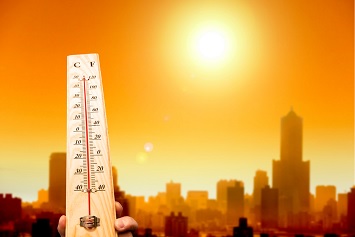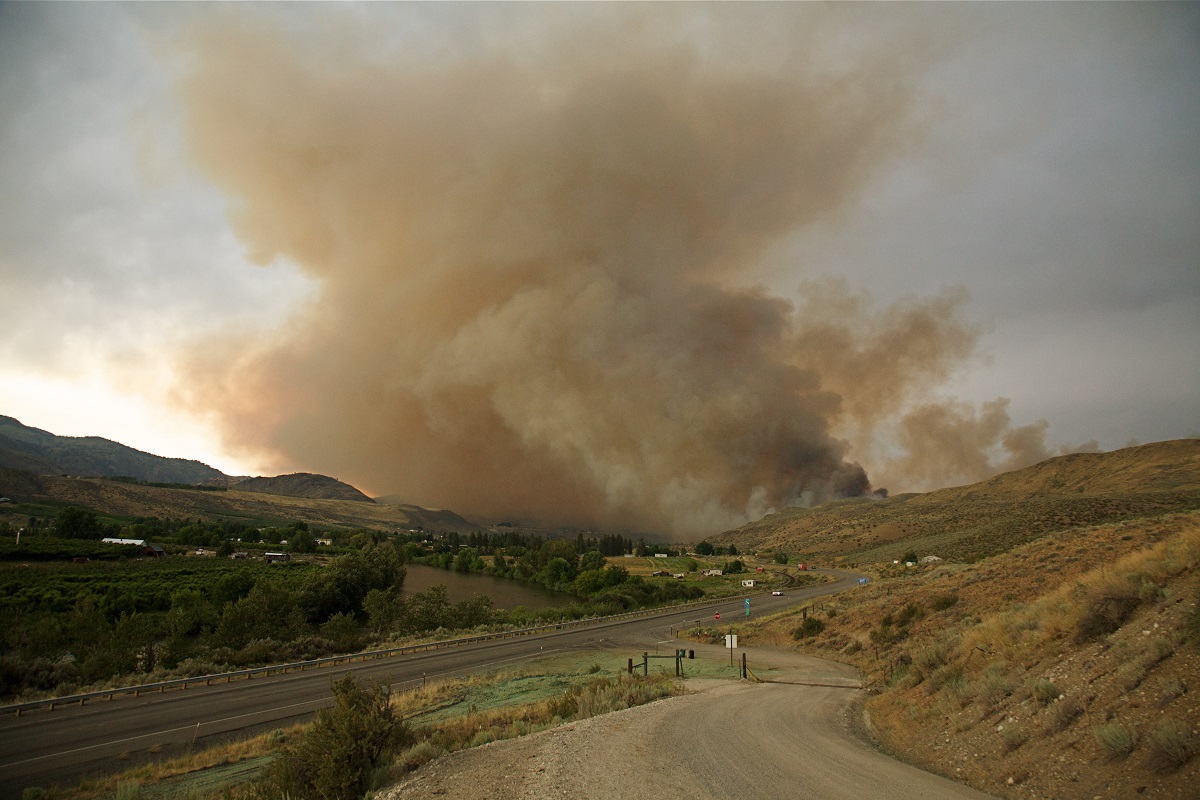Summer safety hazards abound. Are you ready to protect your employees during the Atlantic, Eastern Pacific, and Gulf Coast hurricane season? Wildfires? What about excessive heat? Are you ready for an influx of young workers with little previous work experience and no safety training?
While the COVID-19 pandemic remains the most pressing health and safety issue, infections, hospitalizations, and deaths are all declining as the Johnson & Johnson, Moderna, and Pfizer vaccines roll out across the country. However, summer brings its own seasonal hazards and challenges.
Another Active Hurricane Season
Hurricanes are storm systems with circulating air and sustained wind speeds of 74 miles per hour or higher, but winds can reach speeds exceeding 155 miles per hour. Heavy rains and storm surges can cause flooding.
The 2020 Atlantic hurricane season was extremely active, with a record-breaking 30 named storms, 12 of which made landfall in the continental United States, according to the Department of Commerce’s National Oceanic and Atmospheric Administration (NOAA). NOAA exhausted its list of 21 storm names and had to resort to using Greek letters for 9 of the season’s storms.
While NOAA’s experts do not expect the same level of storm activity in 2021, they do anticipate another above-average Atlantic hurricane season. And the average has been increasing. Updated averages for the Atlantic hurricane season have increased to 14 named storms and 7 hurricanes. The average for major hurricanes (Categories 3, 4, or 5) remains unchanged at 3. The new average is based on a 30-year record for the 1991 to 2020 hurricane seasons. The Atlantic hurricane season begins June 1 and runs through November 30.
While the increase may be due to warming ocean and atmospheric conditions influenced by climate change, the increase in averages also can be attributed to an improvement in observation, including the use of NOAA’s next-generation environmental satellites and continued hurricane reconnaissance.
The Central Pacific hurricane season may be near or below normal in 2021, according to NOAA. There is a 45% chance of near-normal activity during the Central Pacific hurricane season this year and a 35% chance for below-normal activity, according to NOAA’s Central Pacific Hurricane Center and Climate Prediction Center. The Central Pacific hurricane season begins June 1 and runs through November 30.
The effects of hurricanes are not limited to Hawaii, Puerto Rico, the U.S. Virgin Islands, or Southeastern and Gulf Coast states. Southern New England may be subject to coastal flooding due to storm surges, inland flooding due to heavy rains, and widespread wind damage, according to the Connecticut Division of Emergency Management and Homeland Security.
All employers in hurricane-prone areas need to prepare for weather emergencies. It is important to have an evacuation plan. A plan should specify the conditions that would activate an evacuation, as well as a chain of command and designated emergency functions and who will perform them. A plan needs to include specific evacuation procedures, including exits and evacuation routes, as well as procedures for accounting for customers, employees, and visitors.
The Federal Emergency Management Agency (FEMA) has instructions for sheltering in place when evacuation is impossible or impractical.
During or after a hurricane, emergency response and recovery workers face multiple hazards, including carbon monoxide exposure from portable generators, cuts and lacerations, electrocution, falls, hazardous substances and infectious materials, heat exposure, and occupational noise. Recovery workers need protective gear, beginning with appropriate clothing and extending to American National Standards Institute (ANSI)-approved protective footwear, gloves, hard hats or helmets, and safety glasses with side shields. They may need respiratory protection when they may be exposed to hazardous substances and protective chaps when using chain saws. In certain regions, workers may need snake boots or snake garters.
Wildfires
Drought conditions have made wildfires and wildfire smoke common hazards in the western half of the United States. The inland Northwest, intermountain West, and Southwest are all forecast to have an above-normal fire potential this year, according to the National Interagency Fire Center (NIFC). Warmer and drier-than-normal activity was observed this winter and spring on the West Coast and into the Southwest, as well as in New England.
Drought conditions may continue or even worsen across the Western U.S. and portions of the Great Plains, contributing to wildfire risks. Large swaths of extreme to exceptional drought persist in the Southwest, in the Great Basin, and on the Western Slope of Colorado. Portions of the Plains remain in drought. Drought conditions have expanded and intensified in California and southern and central Oregon.
Wildfire preparedness plans like those for hurricanes should include conditions that trigger evacuation, assigned roles and a chain of command, and specified exits and evacuation routes. Even if a facility or worksite isn’t threatened by fire itself, wildfire smoke presents a respiratory hazard. Outdoor workers may need to be transported to an area with better air quality.
If you have a facility in a fire-prone region, you need to ensure that your heating, ventilation, and air conditioning (HVAC) system is working properly and that air filters are clean. You may want to consult an HVAC technician about the highest filtration rating your HVAC system will support and use the highest rating possible when smoke is present.
Heat Stress
When each new summer becomes “the hottest summer on record,” protecting employees from heat stress continues to be a challenge. If you’re in agriculture, construction, landscaping, or another outdoor industry, you need to monitor media for National Weather Service heat advisories. If you have any workers who spend a significant amount of time working outdoors like groundskeepers or security guards, you need to take steps to prevent heat illness. Even workers in un-air-conditioned vehicles used for delivery or transportation, as well as workers in un-air-conditioned warehouses, are at risk.
Preventing heat illness requires you to provide workers with water, rest, and shade. Workers unaccustomed to working in heat need to acclimatize to it, taking time to build a tolerance for hot conditions. The acclimatization period involves taking adequate amounts of liquid, working shorter shifts, and learning how to recognize heat illness symptoms.
There currently is no federal heat illness or heat stress standard. The Occupational Safety and Health Administration (OSHA) cites and fines employers under the General Duty Clause of the Occupational Safety and Health Act of 1970. However, some states have heat stress or heat illness prevention standards. Minnesota has a standard for both cold and heat exposures.
 California has one of the strictest heat illness prevention standards. Under Cal/OSHA’s standard, employers must provide shade when workers request it or when temperatures exceed 80 degrees Fahrenheit. In California, employers and worksite supervisors need to encourage workers to take a cool-down rest in the shade for at least 5 minutes when they feel the effects of heat.
California has one of the strictest heat illness prevention standards. Under Cal/OSHA’s standard, employers must provide shade when workers request it or when temperatures exceed 80 degrees Fahrenheit. In California, employers and worksite supervisors need to encourage workers to take a cool-down rest in the shade for at least 5 minutes when they feel the effects of heat.
Last year, COVID-19 complicated heat illness prevention efforts. Mask-wearing often exacerbated the effects of heat and humidity. Social distancing requirements necessitated staggering breaks and providing additional shaded break areas. The Centers for Disease Control and Prevention recently updated it COVID-19 recommendations, deciding that the fully vaccinated need not wear masks or maintain distances of 6 feet.
Young Workers
Every summer also sees an influx of young, seasonal workers who may have no previous work experience or familiarity with workplace hazards. Common industries for young workers include construction, farm work, landscaping, life guarding and parks and recreation, and restaurants and retail.
Last year, the National Institute for Occupational Safety and Health (NIOSH) released a multiyear study of nonfatal workplace injuries in young workers. Over a 7-year period, from 2012 to 2018, an estimated 3.2 million young workers (15- to 24-year-olds) experienced nonfatal, work-related injuries requiring treatment in a hospital emergency department. Compared with adult workers, young workers experience higher rates of job-related injuries.
While overall rates of nonfatal injuries declined over the 7-year period, workers 15–24 years old experienced rates 1.2 to 2.3 times higher than workers 25–44. Workers 18–19 had the highest rate of injuries requiring treatment in an emergency department.
An earlier study reported that 5,719 young workers died from occupational injuries over a 10-year period (from 1998 to 2007).
NIOSH views schools as an appropriate venue for reaching young workers before their first jobs. The institute developed Youth@Work—Talking Safety, a foundational curriculum in occupational safety and health, as part of its “Safe • Skilled • Ready Workforce” program.
The curriculum consists of a series of lessons designed for 45-minute class periods and is aimed at helping teens develop 8 core competencies in workplace safety and health:
- Recognizing that, while work has its benefits, all workers can be injured, become sick, or even be killed on the job. Workers need to know how workplace risks can affect their lives and their families.
- Recognizing that work-related injuries and illnesses are predictable and can be prevented.
- Identifying hazards at work, evaluating their risks, and predicting how workers can be injured or become sick.
- Recognizing how to prevent injury and illness, describing the best ways to address workplace hazards, and applying the concepts to specific workplace problems.
- Identifying emergencies at work and deciding on the best ways to address them.
- Recognizing the employer and worker rights and responsibilities that play a role in safe and healthy work.
- Finding resources that help keep workers safe and healthy on the job.
- Demonstrating how workers can communicate with others, including people in authority roles, to ask questions or report problems or concerns when they feel unsafe or threatened.
The interactive curriculum is geared toward middle and high school students. There are versions of Talking Safety customized for all U.S. states, the District of Columbia, the U.S. Virgin Islands, and Puerto Rico, as well as Spanish-language versions. The institute also offers a Staying Safe at Work program for workers with intellectual and developmental disabilities.
NIOSH and the American Industrial Hygiene Association (AIHA) also produced a
a 1-hour interactive teaching module and PowerPoint® presentation, Safety Matters, designed for safety professionals and targeting students in grades 7 through 12. The Safety Matters module focuses on the same workplace safety and health competencies as the school-based Talking Safety program.
NIOSH cautions employers to avoid making assumptions about what young workers know, even things that may seem obvious, and to understand that young workers may be embarrassed or uncomfortable asking questions. Young workers should be supervised closely at first to immediately correct any risky work methods or behaviors. They need to be taught how to handle emergencies and how to wear personal protective equipment (PPE) properly.
Depending on your industry and region, you may encounter several challenges as summer begins: heat, hurricanes, wildfires, and young untrained workers.


